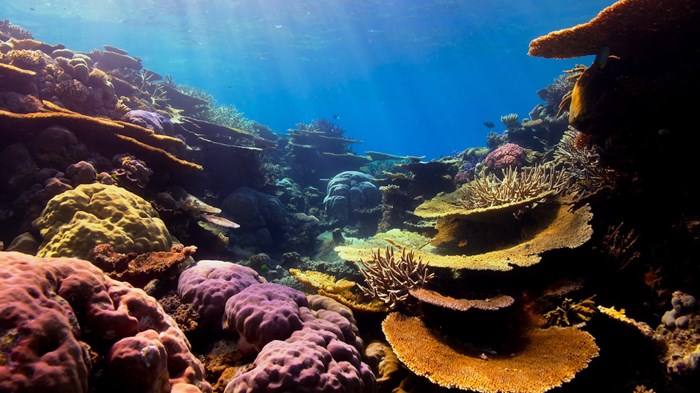Coral Reefs, Creation Care, and the Hope of Resurrection

“…but hope that is seen is not hope; for why does one still hope for what he sees? But if we hope for what we do not see, we eagerly wait for it with perseverance.” Romans 8:24-25, NKJV
Corals are bleaching at an alarming rate, leaving animals homeless and people unprotected. Yet when I consider science and scripture, I unexpectedly find renewed hope in their recovery and restoration.
Perhaps when we think of animals, we think of warm and fuzzy mammals, but corals are some of the simplest, yet diverse animals found in nature —even if they look more like a plant or rock. Corals provide a home to millions of species of organisms and help protect land from flooding and erosion.
Many corals form close friendships with algae. The coral provides a home and protection to the algae, which lives inside the safety of its cells.The algae provide nutrients to the coral and produce the pigments that give them their characteristic color.
When corals are stressed due to changes in temperature, light, or nutrients, their friendship bond with algae is sadly broken. For example, warmer water temperatures can cause resident algae to enter energy and nutrient overdrive, releasing toxic levels of chemicals that hurt the coral. Their relationship becomes more toxic than beneficial from the stress, resulting in the coral forcing the algae out. When the algae are gone, all that remains is a white ghostly skeleton, giving rise to the term coral bleaching.
Bleached corals are still living, but they are nonetheless fragile and vulnerable. Although bleached corals can recover, repeated stress increases the chance of the coral permanently dying. And their death impacts the most vulnerable.
Coral bleaching can be caused by climate change, pollution, and overfishing—all of which bear some level of human responsibility.
Hope for Corals
Recently, a group of scientists observed the Mediterranean Pillow coral “coming back to life” after it was thought to be completely dead. The researchers were able to capture this event patiently and persistently by visiting the same coral colonies for sixteen years, documenting them every summer with detailed photographs and sketches of individual polyps. One year, the water reached a deadly warm temperature, completely ravaging the coral colonies until no life could be detected. But, remarkably, “some of the colonies [that were] considered completely dead” started to show signs of life.
Scientists call this process of recovery "rejuvenescence." Prior to this, rejuvenescence had only been documented in the fossil record. This was the first time it had been observed and captured in real time. While rejuvenescence isn’t quite a “resurrection,” the process isn’t any less miraculous.
The team of scientists who made this discovery see the rejuvenescence of the Mediterranean pillow coral as “a beacon of hope among so much pessimism surrounding the future of reefs.” Scientists have tried other ways to recover colonies of coral, like nurturing them in nurseries and even attempting to cryogenically freeze them, but rejuvenescence is unlike either of these strategies because it can happen without human intervention. This is a testament to the resilience built into the fabric of nature. Hopefully, we can replicate the conditions that promote rejuvenescence in other areas where coral needs to be revitalized.
Hope for all of Creation
As a Christian and scientist, rejuvenescence in coral gives me hope as well—not only a hope in coral’s recovery process and other scientific efforts to save the species, but also in the restoration of all creation that remains to be seen.
Scripture tells us that hope that is seen is not really hope at all, which might sound counterintuitive. I don’t think scripture’s definition is meant to downplay hope or give us less to be hopeful for by limiting the contexts where hope can happen. Rather, scripture challenges us to consider that hope is beyond physical evidence—and that it too is resilient.
Our hope is not a “twiddle-your-thumbs and wait" kind of hope. It is an eager one that requires action and perseverance, especially with organisms like coral which can live for thousands of years. Our hope must be built for the long-haul.
Scripture tells us that all of creation cries out, longing for its redemption from pain and suffering. Corals are no exception. Research has shown that corals release chemical “distress” signals for help when they’re in trouble. Perhaps we will someday be able to detect these distress signals and respond more quickly to their cries.
Until then, I know that there is a God who hears and sees them. He has equipped and called us to help. May we be instruments of God’s hope, and bring about a little more of Heaven on Earth by caring for creation.
Climate Change & Coral Bleaching Resources:
-
Katherine Hayhoe, a Climate Scientist and Christian. Her website features countless resources for some of the most common questions she gets.
Action/Activism:
-
A Rocha, Christian conservation organization.
-
Climate Vigil—join the movement, host a vigil with liturgy and prayer at your church.
Additional Reading:
-
Saving Us: A Climate Scientist's Case for Hope and Healing in a Divided World by Katherine Hayhoe
-
A Christian's Guide to Planet Earth: Why It Matters and How to Care for It by Betsy Painter
Ciara Reyes-Ton is a biologist, science writer, editor, and singer-songwriter who is passionate about science communication to faith communities. She has a Ph.D. in Cell & Molecular Biology from the University of Michigan, and a B.S. in Biology from Valparaiso University. She is currently the Digital Content Editor for BioLogos and an Adjunct Professor at Lipscomb University. This article was adapted from her book “Look Closely,” a science and faith devotional published by Science for the Church that explores the life of Christ by bringing scripture in conversation with science, from water-walking lizards to dividing cells and resurrecting corals.
The Better Samaritan is a part of CT's
Blog Forum. Support the work of CT.
Subscribe and get one year free.
The views of the blogger do not necessarily reflect those of Christianity Today.






















